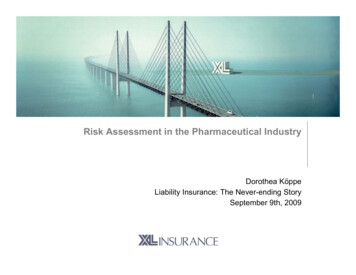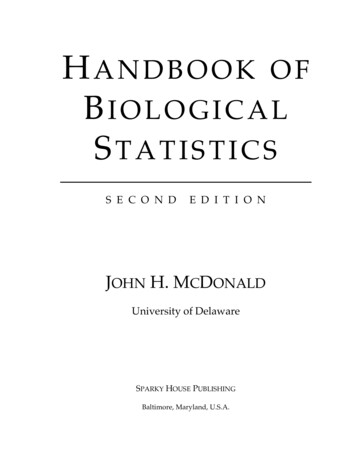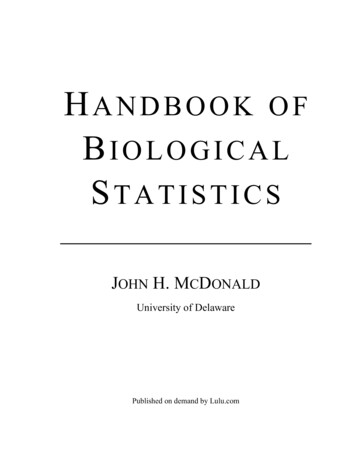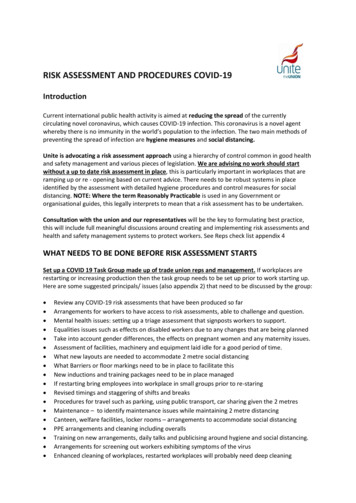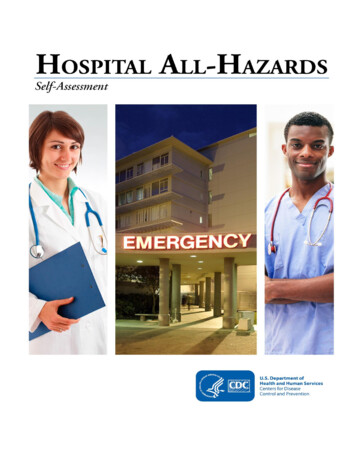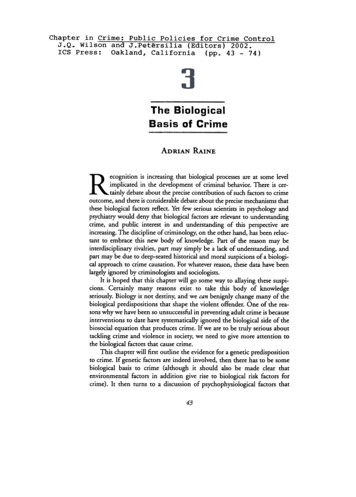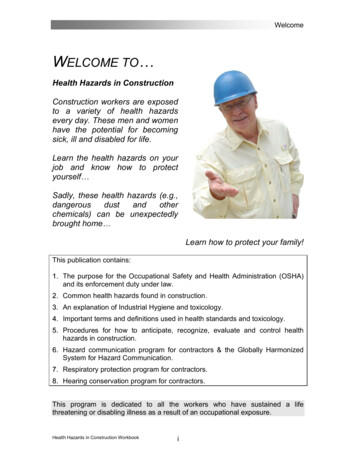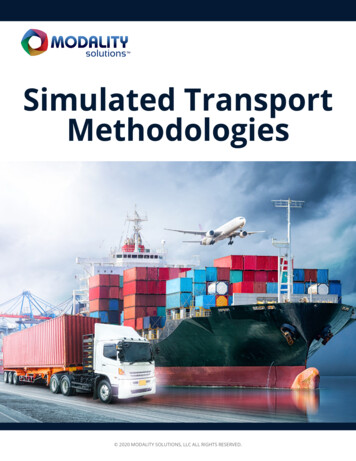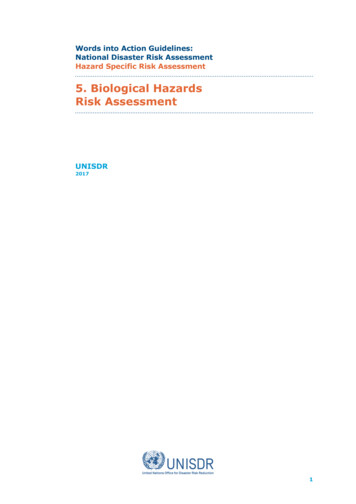
Transcription
Words into Action Guidelines:National Disaster Risk AssessmentHazard Specific Risk Assessment5. Biological HazardsRisk AssessmentUNISDR2017 1
Biological hazards are a major source of risk that may result in emergenciesand disasters. They cause significant loss of life, affect many thousands ofpeople, have the potential for major economic losses through loss of livestockand crops, and may also cause damage and loss to the natural heritage,including to endangered fauna and flora.The management of risks due to biological hazards is a national andcommunity priority. It has been recognized as part of the Sendai Framework,and is globally addressed under the International Health Regulations (IHR).Biological hazards – what are they?Biological hazards are of organic origin or conveyed by biological vectors,including pathogenic microorganisms, toxins and bioactive substances.Examples are bacteria, viruses or parasites, as well as venomous wildlife andinsects, poisonous plants, and mosquitoes carrying disease-causing agents[1].1 These hazards are usually the result of a natural occurrence, but canalso result from deliberate or accidental release.Biological hazards also pose a risk to animals, including livestock, and toplants. However, we are focusing here on human health. The consequences ofa biological hazardous event may include severe economic and environmentallosses. Some examples of recent large outbreaks,2 epidemics3 or pandemics4due to biological hazards either on their own or following a disaster are: The Ebola Virus Disease outbreak in West Africa in 2013-2016, the largestepidemic of its kind to date in the populations of Guinea, Liberia, andSierra Leone. The ongoing outbreak of Zika virus infection in the Americas and the Pacificregion, associated with congenital and other neurological disorders. Significant increase in diarrheal disease incidences following recurrentfloods in most African countries or significant increase following the 2004tsunami in Indonesia and Thailand [2]. Outbreaks of yellow fever in Angola, the Democratic Republic of Congo andUganda in 2016. 2 A disease outbreak is the occurrence of cases of disease in excess of what would normally beexpected in a defined community, geographical area or season. An outbreak may occur in arestricted geographical area, or may extend over several countries. It may last for a few days orweeks, or for several years. A single case of a communicable disease long absent from apopulation, or caused by an agent (e.g. bacterium or virus) not previously recognized in thatcommunity or area, or the emergence of a previously unknown disease, may also constitute anoutbreak and should be reported and investigated. www.who.int/topics/disease outbreaks/en/ 3 Epidemic: The occurrence in a community or region of cases of an illness, specific health-relatedbehaviour, or other health-related events clearly in excess of normal s/en/ 4 A pandemic is the worldwide spread of a new disease. www.who.int/csr/disease/swineflu/frequently asked questions/pandemic/en/ 2
Outbreaks of Middle East Respiratory Syndrome – Coronavirus (MERSCoV), an emerging disease identified in 2012.Assessing the risk of biological hazards can be challenging owing to theirunique characteristics: Agent diversity. Biological hazards range from microorganisms such asbacteria or viruses, to toxins to insect infestations. They can be transmittedto humans from the environment, from animals, from plants, and fromother humans. Routes of transmission. These include airborne transmission, ingestion,absorption (through the skin, eyes, mucous membranes, wounds), animalvectors (e.g. mosquitos or ticks), and bodily fluids (e.g. blood, mother-tochild transmission, sexual transmission). Pathogenicity and virulence. Some biological hazards can cause severedisease in extremely low concentrations and can multiply quickly oncewithin its host. For example, 1-10 aerosolized organisms of Lassa virus orEbola are sufficient to cause severe disease in humans. Hazard identification. As microbes are not visible to the naked eye, theyare often not easy to identify on the basis of epidemiological informationderived from clinical signs and symptoms. They therefore require specificdiagnosis techniques, including polymerase chain reaction (PCR), to amplifya single copy or a few copies of a piece of DNA, microbial cultures, wholegenome sequencing. Endemic diseases with potential for epidemic transmission. Unlikesome other hazards (e.g. earthquakes or floods), biological hazards can bepresent in the community (i.e. they are endemic) and usually pose low riskwhen the population is largely immune. The risk may change when crisesor emergencies arise, exacerbating the conditions favourable for diseasetransmission, or when people migrate from disease-free areas to endemicregions typically lacking immunity, making them susceptible to infectionand transmission of the disease resulting in cases in excess of normalexpectancy. Biological hazards, which are not endemic also pose a riskwhen they are introduced to a new host community with no immunity. Sensitivity to climate, environmental or land use changes. Biologicalhazards – particularly zoonoses5 and vector-transmitted diseases such asmalaria, dengue, Zika and Ebola – may increase in incidence, lethality or change geographic distribution or seasonal patterns directly due to climateand weather sensitivity, environmental or land-use changes, or mediatedthrough changes in ecosystems resulting from human activities, thus 5 Zoonoses are diseases and infections that are naturally transmitted between animals andhumans. A zoonotic agent may be a bacterium, a virus, a fungus or other communicable diseaseagent. www.who.int/neglected diseases/diseases/zoonoses/en/ 3
changing human exposures and susceptibility to these hazards.An estimated 75 per cent of emerging infectious diseases of humans thathave evolved from exposure to zoonotic pathogens [3] warrant riskassessments for health threats at the interface between animal, humanand ecosystems.Assessing the risk of biological hazardsApproaches in assessing the risks of biological hazards differ according to thepurpose of the assessment: Strategic Risk Assessment is used for risk management planning with afocus on prevention and preparedness measures, capacity developmentand medium- to longer-term risk monitoring and evaluation. Rapid Risk Assessment is used to determine the level of risk associatedwith detected events and to define response interventions accordingly. Post-event assessment is used for recovery planning, updating andstrengthening the overall risk management system. Pre-event: Strategic Risk AssessmentsStrategic Risk Assessments are used for risk management planning with afocus on prevention and preparedness and capacity development beforeevents occur. They can be used for medium- to longer-term risk monitoringand evaluation, which tracks changes in risk over time. They catalyse targetedaction to reduce the level of risk and consequences for health based onassessment of the hazard, exposure, vulnerabilities and capacities.In relation to addressing the risk of biological hazards, the term vulnerabilityrefers to the risk factors that exist in exposed populations, such as the burdenof endemic diseases, living conditions (e.g. overcrowding) and environment(e.g. favourable environment for the growing of the pathogen). This is inaddition to factors that are addressed in risk assessments for other hazards,such as demographics (e.g. age or gender), the availability of health servicesto those populations and the degree of resilience of the health systems.Some examples of strategic risk assessment methods for biological hazardsare outlined below.A quantitative microbiological risk assessment (QMRA) is an example of astrategic risk assessment for prevention and mitigation of risks. The hazardidentification includes identifying the characteristics of the pathogen/microbialagent (i.e. case fatality ratios, transmission routes, incubation times ) andthe human diseases associated with the specific microorganism. Thisinformation can be found in the literature and it could be also helpful tosearch for similar outbreaks as references. 4
The exposure assessment of the QMRA measures the dose of the pathogenthat an individual ingests, inhales or comes in contact with. It also requiresdata on the concentration of the pathogen in the source, route of transmissionand timing of the exposure.For this purpose, the QMRA Wiki [4] is a community portal with evolvingknowledge repository for the QMRA. In addition, some other available and freeaccess QMRA tools are E3 Geoportal (European Environment andEpidemiology Network) QMRA for Food and Waterborne Diseases [5] and theQMRA spot for drinking water [6].To prepare for an event involving biological hazards, different approaches toranking risks could be used, including multi-criteria decision analysis (MCDA)and burden of diseases. These approaches allow for better risk prioritizationand planning of public health preparedness.The World Health Organization (WHO) STAR approach to strategic riskassessment enables countries to incorporate an evidence-based approach tostrategic risk assessments. The approach is designed to: engage multisectoralstakeholders around a risk assessment developed for risks affecting publichealth; provide a systematic, transparent and evidence-based approach toidentify, rank and classify priority hazards by level of risk; and for eachhazard, to define the level of national preparedness and readiness required tomitigate its risk. The tool is available from WHO on request.Multi-Criteria Decision Analysis (MCDA) is a stochastic/randomized approachin which several criteria with their levels are identified according to theoutcome of interest. Criteria may include information on epidemiological,economic and perception data of the diseases. The criteria can have equal ordifferent weights depending on their relative importance for the outcome.These data can be collected from literature, databases from the officialsources, prevalence studies or studies in the field, and from expertconsultations. An example is a tool developed by the European Centre forDisease Prevention and Control (ECDC) for ranking infectious diseases tosupport preparedness planning in the European Union/European EconomicArea countries with two versions: a qualitative and less detailed version and asemi-quantitative and more detailed version. Both versions are developed in aflexible way, allowing the users to modify the weighting factors to their owncountries. MCDA has also been applied in the WHO Research andDevelopment Blueprint for action to prevent epidemics, which utilizes acombination of the Delphi technique, questionnaires and multi-criteria decisionanalysis to review and update the Blueprint's priority list of diseases [7].The Global Burden of Disease (GBD) estimates provide comprehensive andcomparable assessment of mortality and loss of health due to diseases,injuries and risk factors, examining trends from 1990 to the present andmaking comparisons across populations. The estimates provides an 5
understanding of the changing health challenges facing people across theworld [8]. GBD research incorporates both the prevalence of a given diseaseor risk factor and the relative harm it causes. The tools allow decision makersto compare the effects of different diseases and use that information forpolicymaking. The flexible design of the GBD machinery allows for regularupdates as new data and epidemiological studies are made available. In thatway, the tools can be used at the global, national and local levels tounderstand health trends over time [9-10].The Burden of Communicable Disease in Europe toolkit [11] estimates theburden for 32 communicable diseases and six healthcare-associatedinfections, applying composite health measures – disability-adjusted life years(DALYs) – to summarize the overall burden in one single metric and comparethe relative burden of each communicable disease.Detection and response: Rapid Risk AssessmentWhen an event occurs, and in order to inform early warning and responsemeasures, the level of risk posed by the event itself is assessed on acontinuous basis through rapid risk assessments [12,13]. The key parametersto take into account in the risk assessment of communicable diseases are theprobability (likelihood of transmission in the population) and the impact(severity of the disease), as well as the context in which the disease occurs.The initial rapid risk assessment must be generated within a short time periodwhen information is often limited and circumstances can evolve rapidly. Theassessment should be undertaken in the initial stages of an event or of anincident being reported and verified, and should ideally be produced within 24to 48 hours. The level of risk should be re-assessed based on evolvinginformation on the event and disease pattern. Risk assessments will helpdetermine whether a response is indicated, the urgency and magnitude of theresponse, the design and selection of critical control measures; and they willinform the wider implications and further management of the incident.In the light of time constraints, the assessment generally relies on publishedresearch evidence, on specialist expert knowledge, and on experiencegathered through previous similar events. Some sources for identifyingoutbreaks and obtaining disease information are listed in the WHO Rapid RiskAssessment manual [12], and in appendix 3 of the ECDC operational guidanceon rapid risk assessment methodology [13]. The principles of transparency,explicitness and reproducibility strictly apply to a rapid risk assessment. Inaddition, uncertainties must be identified, clearly documented andcommunicated. 6
It is important for the public health team in charge of risk assessment to havethe following available: A repository of events that occurred in the past Evidence-based protocols and guidance ready to use for responding toincidents Protocols for identifying sources of key information for rapid riskassessment Strategies for rapid literature searches Lists of experts who can be consulted.Post-event or post-disaster assessments and afteraction reviewsAs health needs might not be immediately apparent, it is important to assessthe risk of biological hazards after natural or human-induced disasters.Damage to health-care facilities and diagnostic and treatment equipment andinterruption of services such as power cuts can have long-reachingconsequences affecting the proper functioning of health facilities, including thepreservation of the vaccine cold chain.The availability of safe water, sanitation facilities and hygiene conditionsbefore, during and after a disaster can greatly determine the impact on acommunity’s health and can result in water-related communicable diseases orvector-borne diseases. Other diseases such as tetanus are also associatedwith natural hazardous events, where contaminated wounds – particularly inpopulations where vaccination coverage levels are low – are associated withillness and death from tetanus.Population displacement is also associated with outbreaks of diseasesassociated with overcrowding. Disasters can also exacerbate noncommunicable diseases and mental health needs and increase demands forsexual and reproductive health services.Post-disaster assessments also inform the implementation of recovery,reconstruction, rehabilitation and restoration of services and other healthrelated activities, including plans for ongoing and latent risks to populationhealth, and the application of “build back better” principle to ensure thatfuture risks of emergencies and disasters are reduced.Health impact assessments include identifying existing and latent risks topopulation health. A rapid risk assessment of these potential risks to humanhealth, and reports on the acute event and syndromic surveillance indicatorsare needed. As an example of how to implement a syndromic surveillance in aspecific population, ECDC launched a handbook and supporting tool forimplementing syndromic surveillance in migrant centres and other refugeesettings [14]. 7
Post-event reviews (e.g. after-action reviews (AAR) or critical incidentreviews) are qualitative reviews of actions at any level, usually focused on theresponse to an event, as a means of identifying best practices and lessonslearned [15]. An AAR seeks to identify what worked well and how thesepractices can be institutionalized and shared with stakeholders; and what didnot work and requires corrective action. AARs can be used as an evaluation ofthe real response capacities and processes in place.AARs following epidemics and pandemics usually include evaluations of thecapacity of the organization and health and multisectoral systems to deal withthe risk, the availability and the enforcement of legal instruments, and issuesof leadership and coordination. For example, several reviews have beenconducted following the Ebola outbreak in West Africa 2013-2016 [16-18]. Atypical review looks at the scale of the epidemic, origins of human infection,spread patterns of the infection, the effects of the interventions taken in bothtiming and magnitude, the declaration of the end of the epidemic, and finallylessons learned for future preparedness and response.Risk assessment and use in national DRR measuresRisk assessment will inform policymaking of the management of the risks,including biological hazards, by answering the following important questions:-Who is at risk? Who is more exposed or in vulnerable situations? What isthe level of exposure and the rate of assumed risky behaviours?-What are the routes of transmissions within and between communities?-What is the level, severity and scale of the risks? What are the establishedthresholds that apply to this particular pathogen based on past and presentdisease incidence?-What is the risk of international spread that warrants reporting the eventunder the International Health Regulations (2005) and which may lead to adeclaration by WHO of a Public Health Emergency of International Concern?-What are the effective treatment and control measures available to use tocontain and stop the risk?-What are the environmental and ecological factors or drivers affecting therisk? What is the likelihood and impact of emerging or evolving healththreats? How can they be mitigated?-What are the contextual factors to take into account when managing therisks? These include public perception and behaviour, media interest andpolitical and economic issues. 8
Policy makers and DRR practitioners use this information to trigger actionsthat reduce risk of biological hazards i.e. effective and timely prevention,preparedness and response actions, including measures to reduce exposure ofgroups at increased risk of infection due to biological hazards, contain thespread of the risk, and eventually stopping it.Measures include protective equipment, behaviour-change practices by raisingawareness and education of the public through appropriate communicationchannels, and effective treatment and/or vaccine if and when available.Risk information is also used to inform preparedness and contingencyplanning at various levels and capacity-development measures for healthworkers to match the full risk profile of the community, including for biologicalhazards.Risk assessment information provides the foundation for investment inmeasures to reduce the risk. For example, identification and mapping ofhazardous areas inform the decisions for building critical infrastructure suchas water, sanitation and health systems and services to manage the risks ofbiological hazards as well as other types of emergencies. They also providethe foundation for developing financial applications to manage or transfer therisk.Impact modelling and rapid risk assessment inform early and rapid estimatesof impacts on the populations, on services in health and other sectors, andprovide critical information for recovery and rehabilitation reconstruction whenneeded. 9
Case studies of a country good practiceCase study: Rapid Risk Assessment of a severerespiratory diseaseEvent: A cluster of 22 cases of severe respiratory disease with seven deathsin country X were admitted to hospital over the past 17 days. The event isoccurring 8 km from the border and cases have been reported from threevillages by a local health-care worker. The area is the poorest in the countryand health infrastructure is limited.Many of the health-care facilities charge a consultation fee and consequentlythe local population self-medicates during mild illness. There are also strongbeliefs that “strange diseases” are caused by sorcery.Risk question: What is the likelihood of further spread of severe cases ofrespiratory disease and what would be the consequences (type andmagnitude) to public health if this were to occur?Information used to assess the likelihood of further spread: Cases are still being reported 17 days after the first known cases weredetected The specific hazard and mode(s) of transmission have not been identified It is also likely that some cases are not being detected (e.g. mild cases areless likely to seek care from health services and are therefore not includedin the official reports).Therefore, if nothing is done, it is highly likely that further cases will occur.Information used to assess the consequences of further spread: The disease has a high case fatality ratio (even when underreporting istaken into account) The health-care system is poor and the ability to treat the cases is alreadylimited; newadmissions will further stress acute care services and lead to worse clinicaloutcomes for hospitalized patients Negative economic and social impact of the cases and deaths in theaffected communities Potential for unrest in communities because of cultural belief that sorcery iscausing the deaths The event is occurring in a border area and could affect the neighbouringcountry. 10
Therefore, if further cases occur, the consequences will be severe.Using the risk matrix to combine the estimates of likelihood and consequencesleads to an estimate of the overall risk. In this case, the overall level of risk ishigh. The confidence in the risk assessment is low to medium.Although the report is from a local health-care worker, the information islimited and it is not clear if that person has examined the suspect cases or ismerely reporting a rumour.Source: HO HSE GAR ARO 2012.1 eng.pdf 11
Case study – Collaboration between the ChiefEpidemiologist and Civil Protection in Iceland onrisk assessment An island country located in the North Atlantic Ocean, Iceland has apopulation of some 330,000 inhabitants and an area of 103,000 km2, makingit one of the most sparsely populated countries in Europe. Over two thirds ofthe population live in the southwest part of the country, which makes up theReykjavik area, while the rest are scattered along the coastal area.Iceland’s Chief Epidemiologist and the Civil Protection service of the NationalCommissioner of Police are responsible for the national preparedness planningfor communicable diseases, as well as chemical, biological and radio-nuclearhazards and events where the source is unknown. Additionally, the ChiefEpidemiologist, in cooperation with the Civil Protection service, is responsiblefor the national risk assessment, risk reduction and response management forthese types of events.In times of crisis, the risk assessment is performed in cooperation withresponders and scientists at formal meetings at the National CoordinationCentre. Meetings are scheduled as often as needed and a press releaseissued after each meeting. The objective of the meetings is to shareinformation, assess the risk and decide whether preparedness plans should beactivated.The preparedness plans in Iceland are all-hazard plans and involve thefollowing sectors [19]: primary health care and hospitals, ambulance services,distributors of medicines, Icelandic Medicine Agency, Icelandic Food andVeterinary Authority, food suppliers and distributors, the Farmers Associationof Iceland, Icelandic Transport Association, Icelandic Tourist Board, thefinancial sector, Icelandic Environmental Agency, Icelandic federation ofenergy and utility companies, Icelandic road and coastal administration,prisons, Red Cross and rescue services, Icelandic National BroadcastingService and the Evangelical Lutheran Church of Iceland.The main health hazards in Iceland result from natural hazards such asvolcanoes, earthquakes, avalanches and severe weather. Hazards fromvolcanoes have been a great concern in Iceland for years. These hazards canresult from heavy ash fall and various gases being emitted from eruptions, themain one being sulphur dioxide (SO2).The evaluation of possible health effects involves various agencies but thefinal risk assessment, risk mitigation and communication to the public is theresponsibility of the Chief Epidemiologist and Civil Protection. SeveralIcelandic studies have been published that describe the health effects ofvolcanic eruptions in Iceland. These studies are invaluable in the making ofpreparedness plans for hazards due to volcanic activities in Iceland as well asfor carrying out risk assessment and risk reduction. 12
Resources for further information Open-source modelling tools available E3 Geoportal (E3 tools): Vibrio, West Nile, E3 map viewer (Dengue,Chikungunya, mosquitoes), Quantitative Microbial Risk Assessment for foodand waterborne diseases (QMRA). ECDC Legionnaires’ disease GIS tool. “It allows field epidemiologists toquickly plot cases and potential outbreak sources, and to make a basicspatial analysis to support the source identification”. European Up-Front Risk Assessment Tool (EUFRAT). “Quantification of therisk of infection transmission by blood transfusion in an outbreak-affectedregion, or the risk from a stream of donors who have visited such aregion”. Global Burden of Disease Data Tool. “[ ]tool to quantify health loss fromhundreds of diseases, injuries, and risk factors, so that health systems canbe improved and disparities can be eliminated”. Burden of Communicable Disease in Europe toolkit. “[ ] stand-alonesoftware application which allows calculation of disability-adjusted lifeyears (DALYs) for a selection of 32 communicable diseases and sixhealthcare-associated infections”. Joint External Evaluation Tool. “[ ] is intended to assess country capacityto prevent, detect, and rapidly respond to public health threatsindependently of whether they are naturally occurring, deliberate, oraccidental”.List of entities to consult for more guidance onhealth risk assessmento Departments of health at national, provincial and municipalitylevels Health emergency management sections Civil protection agencies Food safety agencies Vector control agencies Water and sanitations agencies Civil society organizations working on health: including NGOs, associationsof doctors, nurses, public health professionals and foundations on health International and regional organizations working on health, such as WHOand ECDC. 13
References1. United Nations (2016). Final report of the open-ended intergovernmentalexpert working group on indicators and terminology relating to disasterrisk reduction. Available from www.preventionweb.net/files/50683 oiewgreportadvanceuneditedversion.pdf2. Kouadio Koffi Isidore and others (2012). Preventing and controllinginfectious diseases after natural disasters. United Nations University.Available from sasters.html - info3. World Health Organization (2003). Climate change and human health:risks and responses. A. J. McMichael and others, eds. Available ge.pdf4. Center for Advancing Microbial Risk Assessment. Quantitative MicrobialRisk Assessment (QMRA) Wiki 2015. Available from e Microbial Risk Assessment (QMRA) Wiki5. European Centre for Disease Prevention and Control (2017). E3 GeoportalQMRA for Food and Waterborne Diseases. Stockholm: ECDC. Availablefrom https://e3geoportal.ecdc.europa.eu/SitePages/E3 Tools.aspx6. Environment DNIfPHat (2011). Tool for Quantitative Microbial RiskAssessment (QMRAspot) from Surface Water to Potable Water. Availablefrom http://rivm.nl/media/WHO-QMRA/7. World Health Organization (2017). A research and development Blueprintfor action to prevent epidemics. Available from www.who.int/csr/researchand-development/en/8. (2017). Global Health Estimates (GHE). Available from www.who.int/healthinfo/global burden disease/en/9. Institute for Health Metrics and Evaluation (2015). Global Burden ofDisease (GBD) Data tool. Available from www.healthdata.org/gbd/about10. GBD 2016 SDG collaborators and others (2017). Measuring progress andprojecting attainment on the basis of past trends of the health-relatedSustainable Development Goals in 188 countries: an analysis from theGlobal Burden of Disease Study 2016. The Lancet, vol. 390, No. 10100Available from http://thelancet.com/gbd11. European Centre for Disease Prevention and Control (2015). Burden ofCommunicable Disease in Europe (BCoDE) toolkit. Version 1.4. Stockholm:ECDC.12. World Health Organization (2012). Rapid Risk Assessment of Acute Public 14
Health Events.Available from HO HSE GAR ARO 2012.1 eng.pdf13. European Centre for Disease Prevention and Control (2011). Operationalguidance on rapid risk assessment methodology. Stockholm: ECDC.Available from /1108 ted risk
The management of risks due to biological hazards is a national and . strengthening the overall risk management system. Pre-event: Strategic Risk Assessments . infections, applying composite health measures - disability-adjusted life years (DALYs) - to summarize the overall burden in one single metric and compare .
